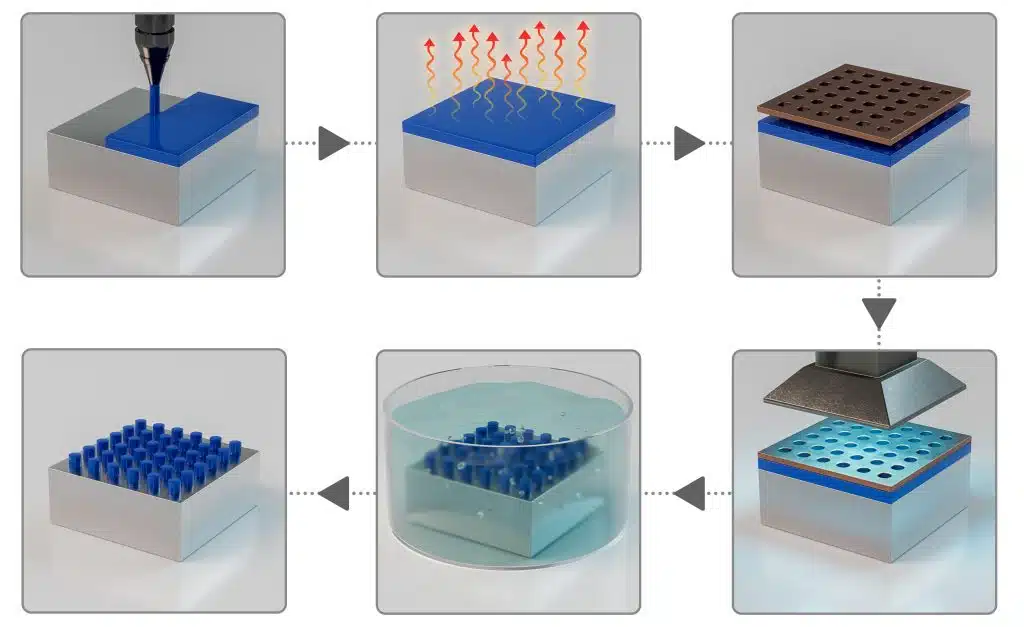SU-8 photolithography is a common microfabrication technique that utilizes SU-8, a photosensitive negative epoxy. The SU-8 creates micro and nanoscale patterns on the surface of a substrate, as well as microstructures and coatings for different applications.
It is a widespread technique due to its stable thermal, chemical, and mechanical characteristics. SU-8 photolithography plays a fundamental part in manufacturing microfluidics and microelectromechanical system components. This article presents the procedure, applications, and instruments employed for SU-8 photolithography.

Image Credit: Platypus Technologies, LLC
Required Components for SU-8 Photolithography
For SU-8 photolithography to be performed accurately, several components are needed, such as a photoresist (SU-8), solvents, substrates, a spinner, hotplates, a mask aligner, and a UV light source.
SU-8
The SU-8 photoresist is a principal component in this process because it is the material needed to produce the required pattern.
SU-8 is a negative epoxy-based photoresist with thermal stability and a high aspect ratio. SU-8 undergoes a chemical reaction when exposed to UV light, which helps create the desired pattern on a substrate.
Substrates
A substrate is a polymer, glass, or silicon base material. A photoresist, such as SU-8, is dispensed onto a substrate. The substrate used for photolithography is based on the intended use and the desired properties of the final product.
Solvents
The selection of a solvent is based on the type of photoresist utilized. In this process, a solvent removes excess photoresist on a substrate surface. Once the undesired photoresist is removed, the desired pattern will be uncovered.
Mask Aligner
A mask aligner is employed to align the photoresist with the required pattern. Once the two are aligned, the mask reveals chosen sections of the photoresist, allowing an exact pattern to be generated.
UV Light Source
The photolithography process is not possible without a UV light source. As aforementioned, the light source reveals the photoresist through the mask aligner and generates a chemical reaction. This chemical reaction creates the required pattern.
SU-8 Photolithography Procedure
The SU-8 photolithography process comprises multiple steps, such as photoresist coating, substrate preparation and development, UV light exposure, and hard-baking the photoresist.
A substrate must be cleaned using a solvent before it can be utilized in photolithography. Examples include methanol, acetone, or isopropyl alcohol.
Following cleaning, the SU-8 is dispersed onto the surface of the substrate using a spinner in a spin-coating process. The photoresist is subsequently soft-baked to enable solvent evaporation.
The following stages involve exposure of the photoresist to UV light through a mask to generate the required pattern, then removal of unexposed areas with a solvent. The last step of the process is hard-baking the photoresist to cure it permanently.
In summary, the photolithography process is comprised of the following steps:
- Substrate cleaning
- Spin-coating the photoresist
- Soft-baking the photoresist
- Exposure of the photoresist to UV light
- Removal of unexposed areas and generation of the pattern
- Hard-baking and curing the photoresist
Learn more about the photolithography process here.
Platypus Technologies and SU-8 Photolithography
Platypus Technologies offers a variety of photolithography services for the fabrication of patterned surfaces.
Platypus Technologies stocks positive and negative photoresists, a fundamental feature of photolithography processes, such as SU-8 patterned wafers for numerous applications, including developing electrodes, biosensors, microfluidics, MEMs devices, semiconductor devices, and many other applications.
To learn more about SU-8 photolithography and how Platypus Technologies can support your applications, contact a member of the Platypus Technologies team today.

This information has been sourced, reviewed and adapted from materials provided by Platypus Technologies, LLC.
For more information on this source, please visit Platypus Technologies, LLC.